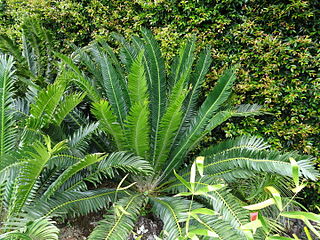
Encephalartos horridus, the Eastern Cape blue cycad, is a small, low-growing cycad up to 0.9 m (3.0 ft) high and 0.9 m (3.0 ft) wide. It is a native of Eastern Cape Province, South Africa, and found in arid shrublands, most commonly on ridges and slopes with shallow soils. The species is particularly known for its distinctly blue-gray leaves, although the degree of coloration can vary significantly. The species name horridus is Latin for 'bristly', after the plant's stiff, spiny leaflets.

Encephalartos ferox, a member of the family Zamiaceae, is a small cycad with 35 cm wide subterranean trunk. It gets its name from the Latin word ferocious, likely from the spine-tipped lobes on the leaves of the plant. It is found naturally on the south-eastern coast of Africa where it has been used by local people for its starch content. It is considered to be one of the most popular cultivated cycads.

Encephalartos lebomboensis is a species of cycad in the family Zamiaceae. Native to the Lebombo Mountains of South Africa, the species was first described in 1949 by the South African botanist Inez Verdoorn. It is commonly known as the Lebombo cycad, although the name is also used for Encephalartos senticosus which also occurs in the same locality.

Encephalartos trispinosus is a species of cycad that is native to the Eastern Cape Province of South Africa.

Encephalartos paucidentatus is a species of cycad.

Encephalartos dolomiticus, the Wolkberg cycad, is a critically endangered species of cycad. It is only found in the Wolkberg at elevations of 1100–1500 meters. The area is near Penge in southeastern Limpopo Province, South Africa.

Encephalartos cupidus is a species of cycad that is found in the Limpopo Province, South Africa at elevations of 700 up to 1,500.

Encephalartos concinnus is a species of cycad in the family Zamiaceae. It is endemic to Zimbabwe. It is known as the Runde cycad.

Encephalartos middelburgensis is a species of cycad that is native to Gauteng and Mpumalanga provinces of South Africa at elevations of 1,100–1,400 m (3,600–4,600 ft).

Encephalartos laevifolius is a species of cycad that is found in the KwaZulu-Natal, Mpumalanga and Limpopo provinces of South Africa, and at Piggs Peak in Eswatini. The species is facing extinction in the wild, but is widely cultivated. As of 2012, the Encephalartos laevifolius has been listed as critically endangered by the IUCN.

Encephalartos hildebrandtii is a species of cycad in the Zamiaceae family. It is native to Kenya and Tanzania at elevations from sea level to 600 metres (2,000 ft). The species is named for the German explorer Johann Maria Hildebrandt.

The Chimanimani cycad is a species of cycad that is endemic to the Chimanimani Mountains of eastern Zimbabwe. It is a threatened species which has been locally extirpated by cycad collectors.
Encephalartos schmitzii is a species of cycad in Africa.
Encephalartos macrostrobilus is a species of cycad in Africa. It is found only in Moyo District, northwestern Uganda, which is populated predominantly by the ethnic Madi.
Encephalartos mackenziei is a species of cycad in South Sudan. It is found in the Didinga Hills of Namorunyang State.

Encephalartos cerinus or Waxen Cycad is a species of cycad in Africa.
Encephalartos dyerianus, known colloquially as the Lillie cycad, is a species of cycad that is native to hillsides in the lowveld of eastern Limpopo, South Africa.
Encephalartos heenanii is a species of cycad in Southern Transvaal Province, South Africa.

Encephalartos humilis is a species of cycad in the former Transvaal Province, South Africa.

Encephalartos umbeluziensis is a species of cycad from Africa.



















